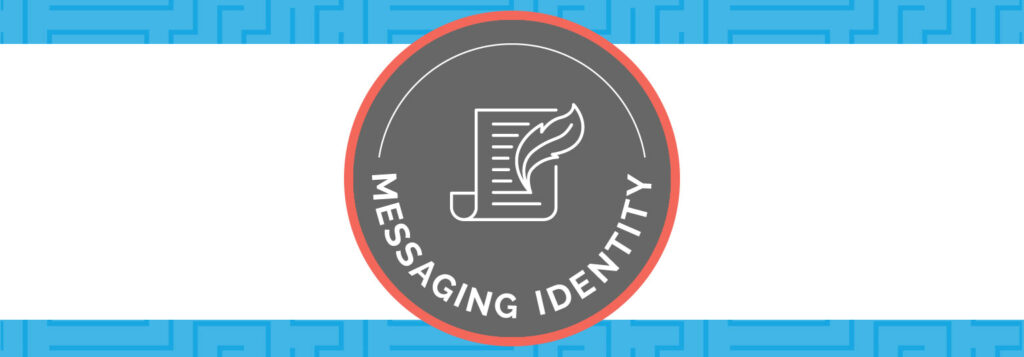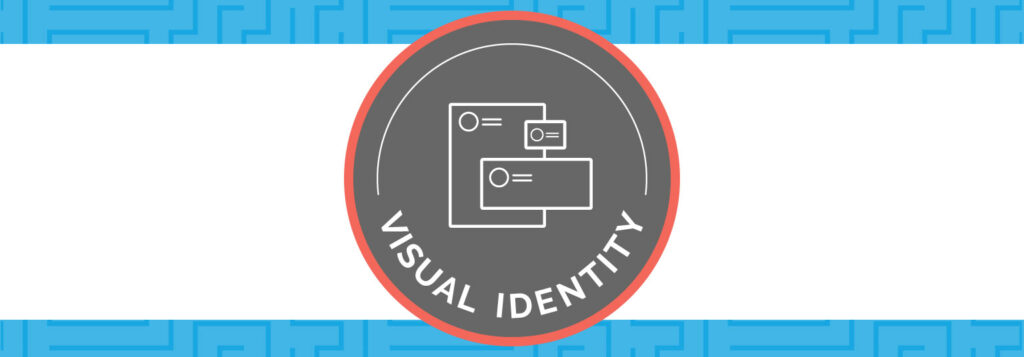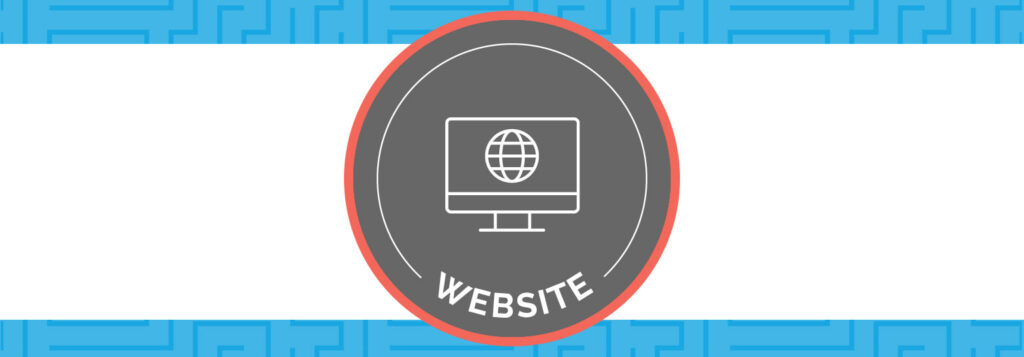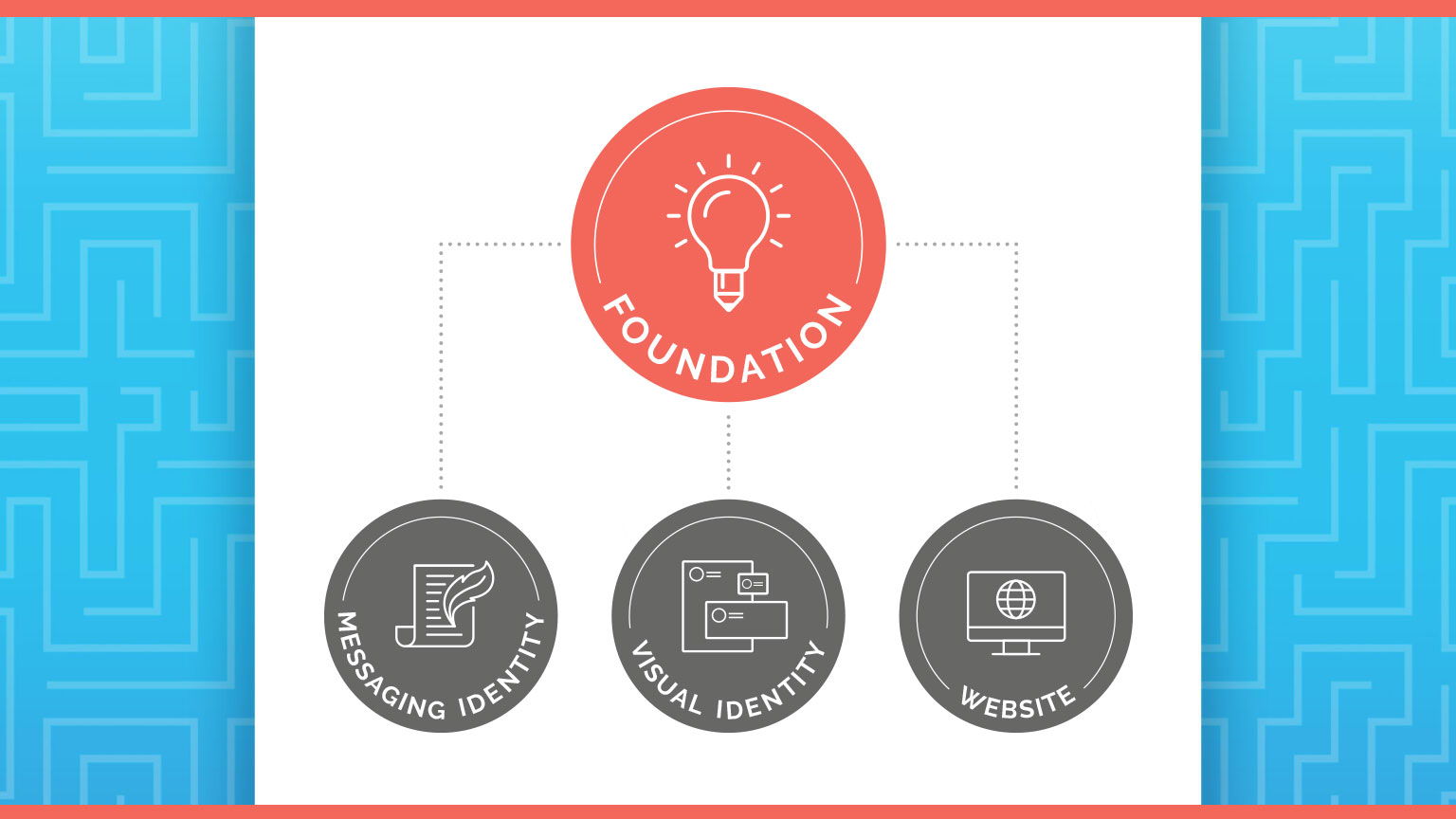At Corporate Three Design, we approach marketing businesses in 3 categories:
- Foundation
- Promotion
- Generation
We’d like it to work in a linear path, but that’s rarely the case. If an organization has their overall business foundation in place, and they create a new product or division, they need to address the marketing foundation before promoting it.

In this post, I’m going to outline the parts we address in an organization’s Marketing Foundation.
What is a Marketing Foundation?
Whether a building or a brand, the foundation impacts the stability of any structure. At Corporate Three Design, we see 3 key ingredients to the marketing foundation of a business.
- Messaging Identity
- Visual Identity
- The Website
What is an Organization’s Messaging Identity?

When we meet with a new client, we want to know what makes them tick. Most times they’ve been in business for awhile. We want to know why they are in the business they’re in. What problems do they solve for their customers? Who is their target audience? What’s their favorite part of what they do?
Many times our customers are so close to their daily business trying to keep things running that they forget the answers to those questions. Taking time with us in the messaging process gives their leadership team a chance to reevaluate and think about why they do what they do. What they do matters to their customers otherwise they wouldn’t still be in business.
Messaging Identity Process
Our process involves talking with the key stakeholders of the organization and asking a series of questions. Many times we’ll want to talk with some of their key customers too. We want to hear in the customer’s own words why they work with that organization. A business who knows their mission, vision and values is really helpful for this process. We can help an organization through that process if they haven’t identified those.
After we’ve gathered all of the information, we sift through it all looking for the common thread that has made the business tick for so long. From there we create the first iteration of the messaging identity. We review with the client and make changes until the client approves the messaging pieces.
Messaging Identity Deliverables
At the end of the messaging process, we will deliver:
- Story Talking Points
- Elevator Pitch
- Tagline (if needed)
What are Marketing Story Talking Points?
Because a human’s brain is wired for story, we identify messaging points that follow elements of the hero’s journey. Examples include the character (target audience), the conflict (the problem that the target audience is experiencing, and the guide (the business). We develop talking points with each of these areas that become the language and tone we use in all other projects developed like the website, sales sheet, social media posts, etc…
Elevator Pitch
After we solidify the Story Talking Points with the organization’s key stakeholders, we start working on the elevator pitch. You’ve probably heard of an elevator pitch before, but you may have never thought of it in a narrative framework. Going back to the idea that a human’s brain is wired for story, we take the main talking points, and condense it into a simple sentence or two that follow a basic story structure. The simplest structure of a story is “problem, solution, resolution.” In the case of a business narrative structure, we follow this structure: client’s problem, the solution the business offers, and the result of having the problem solved.
Tagline
When we’re working on taglines for a business, we want to make sure they understand who they’re for and the solution they deliver. We want to know their mission, vision, and values. After that we start asking questions about how they want their customers to feel about their brand and product. This becomes the starting point for their tagline.
Not every brand needs this right away, but as the business begins to understand its place in the marketplace and starts differentiating itself from other businesses this is the next step.
What is a Brand’s Visual Identity?

After a business knows who they are and who they help, we want to make sure it comes through visually. This starts with the logo, colors, fonts and image styles. The messaging identity and visual identity coming together start forming the basis of the brand. (The customers’ perception is going to be influential on what the brand becomes.)
We focus on the visual identity in 3 main ways:
- The Logo
- Collateral
- Brand Guidelines
The Logo
A logo is a graphic representation of a business name. A logo can be the name of the business in a stylized font, it can also be coupled with a graphic icon, or the whole business name could be a graphic icon.
For businesses who come to us already having a logo, we may only make slight modifications or no changes at all. We may just adjust the other elements (color, fonts, images) to change the emotion the business wants to evoke.
For businesses who are looking to reinvent their brand, we’ll start with an entirely new logo. It’s a fun and daunting process trying to represent an organization visually.
Collateral
With a logo, colors, and fonts decided upon, we’ll start working on the supporting collateral pieces. This usually starts with the stationery package:
- Business cards
- Letterhead (physical and digital)
- Envelopes
But it also ends up including anything the business uses to represent itself, such as:
- Presentation templates
- Email templates
- Employees email signatures
- Sales sheets or leave behinds
- Social media icons and headers
- Building signage
- Apparel
- Advertising
Brand Guidelines
After we’ve gone through the messaging identity process and the visual identity piece, we like to work with businesses – especially larger organizations – to create Brand Guidelines. This document is the organization’s bible for how to use the logo, fonts, colors, imagery, and messaging.
An organization spent time going through the process of determining what they want to be known for, how they want that communicated, and how to visually communicate that. Now it needs to be protected. When businesses get into the day in and day out of running a business, the Brand Guideline is a place for to go back and remember the work put in to figure out the brand ‘s identity.
For larger organizations, this is especially helpful because it gives the entire staff a place to reference what should and should not be done to maintain the brand’s integrity. HR will have a reference for what to create for apparel and online ads for hiring. It gives the sales team a place to begin for their proposals and any additional materials they might need.
Brand Guidelines are an invaluable tool to document all the decisions a business has made.
A Website Built to Grow the Marketing Foundation

When we work with clients, we start the Messaging Identity and when we’ve gotten a little way into the process, we start working on the Visual Identity. When client approves the messaging and logo, we start working on the website.
We include the Website as part of the Marketing Foundation, because it has become so central to how a business grows. An organization’s website is a tool to help generate revenue for the business, and that’s how we treat it. It’s not a quick process. Time and attention need to go into caring for the website to see a return. We don’t recommend flash in the pan ideas; we recommend strategies and solutions that have been successfully time tested.
Even with the advent of being able to run a business from social media, we hold fast to the idea that an organization should own their location online. That means owning their own url and website content.
We build sites designed to grow with our clients, and we outlined our website build process in this blog post.
New Business Website
If a client is just starting out, we want to get them online as quickly as possible. We offer a Small Business website that makes use of a simple WordPress template that we customize with their logo and colors. From the Messaging Identity, we create homepage content written with a call to action as the end goal. Next we’ll make sure there’s an About page, Products or Services pages, a Blog section and a Contact page. That’s enough to get a business off the ground and running.
Established Business Website
If we’re working with an established business, we’ll spend time auditing the content and traffic on their existing site and building a new web strategy to capitalize on what’s already going well. Pages may be eliminated, added, or combined. We’ll talk about lead generation strategies and make plans for landing pages specific to their goals.
After the Website Launch
Once a website is launched, we wait 3 months for the traffic patterns to reach a new baseline. After that we review the client’s goals and start establishing Promotion and Generation strategies. These two areas of the wheel will build on the Foundation and turn the website into a tool for business growth.
Ready to Grow
Through the Messaging Identity process, businesses will know who they are, the problems they solve, and the people they solve them for. That information will translate into the Visual Identity to develop logos, colors, fonts and imagery. Together the Messaging and Visual Identities will form the basis for the company’s brand. Our team will bring that information into the Website to position it as a tool that the organization can use to grow.
If your organization is ready to start Marketing Foundation work, our team is excited to help you grow. Send us a message or call 402.398.3333.

